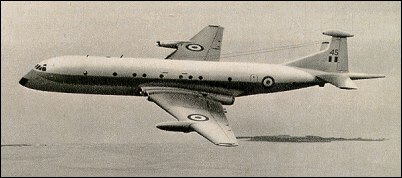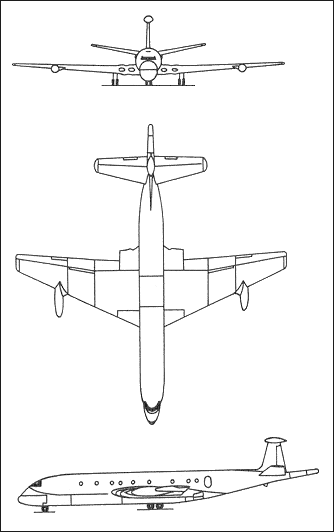|
| The Nimrod has been the Royal Air Force's primary patrol bomber since replacing the Avro Shackleton in the early 1970s. It is a conversion of the De Havilland Comet, the world's first jet airliner. It was originally designed by Hawker-Siddeley, but is today a product of BAE Systems. The Nimrod serves the RAF in two variants: the R1 variant in a reconnaissance and electronic intelligence gathering capacity (ELINT), and the MR2 variant in the Maritime Reconnaissance role.
The Nimrod was the first jet-powered patrol aircraft to be designed; earlier designs generally used piston or turboprop engines to improve fuel economy and allow for long duration patrols. Jet engines are generally very "thirsty" at low altitudes, but the Nimrod's huge fuel capacity made up for this. It can also shut down two engines at low altitude to extend endurance. When needed, the Nimrod could "dash" to its targets at a speed that no propeller aircraft could match. Since the introduction of the Nimrod, most new patrol designs have been jet powered, includingh the US Navy's S-3 Viking and future P-8.

| CREW | 11 |
| ENGINE | 4 x 5510kg Rolls Royce Spey 250 turbofans |
| WEIGHTS |
| Take-off weight | 87000 kg | 191803 lb |
| DIMENSIONS |
| Wingspan | 35.0 m | 115 ft 10 in |
| Length | 38.6 m | 127 ft 8 in |
| Height | 9.0 m | 30 ft 6 in |
| Wing area | 197.0 m2 | 2120.49 sq ft |
| PERFORMANCE |
| Max. speed | 920 km/h | 572 mph |
| Cruise speed | 780 km/h | 485 mph |
| Range w/max payload | 9260 km | 5754 miles |
| Barry, 22.03.2011 14:31 Further to my posting of the 18.09.2009, guess what? The whole project cancelled after millions being spent, and now the great maritime nation of Britain has no maritime reconnaisance ability whatsoever. Unbeleivable!
One of six please write the book I for one would love to read it. reply | | amer.a.r.t.alsaeed, e-mail, 29.05.2010 04:55 I asked last time about the Comet's design, and the details of the wing without the engine, also the designs of dehaveyland Gliders, so please how can I get it. reply | | Amer Al-saeed, e-mail, 23.04.2010 02:25 I would like to download the desgin plotting of the Comet
Airplane including the details of cross sections of fuselage and wing detail or the model Aircraft desgin without the engine details
I wish to get a de haviland desgin of sail_ aircraft model
with tow line of the detail Glider
Please Email me those things
Thank you reply | | One of six, e-mail, 21.09.2009 21:17 As someone who flew the AEW3 during the trials, let me just say that if the radar was sectored away from land (such that no land was radiated), the radar performance was at best only equal to that of the Shackleton it was designed to replace - despite flying at a much greater altitude. So much for your analysis.. There are some huge misconceptions out there about what went wrong that will only be corrected when the book is written. reply | |
| | Barry, 18.09.2009 18:04 Your illustration shows the ill fated AEW3. This was designed as an airborne early warning platform. The problem was that the GEC radar chosen was so sensitive that the radar image was, when flying over the North Sea, cluttered with road traffic in East Anglia, making it impossible for operators to disseminate air traffic. After spending many millions of pounds the politicians decided to cancel the project and ended up buying the Sentry from Boeing. Now there's a surprise.
The current MR4 under development had a planned service entry of 2005 if not earlier and still has to make it's initial flight. Do you think they will cancel it? Don't be surprised, they are at the end of the day worthless politicians. reply |
|
Do you have any comments?
|
| 
COMPANY
PROFILE
All the World's Rotorcraft
|








